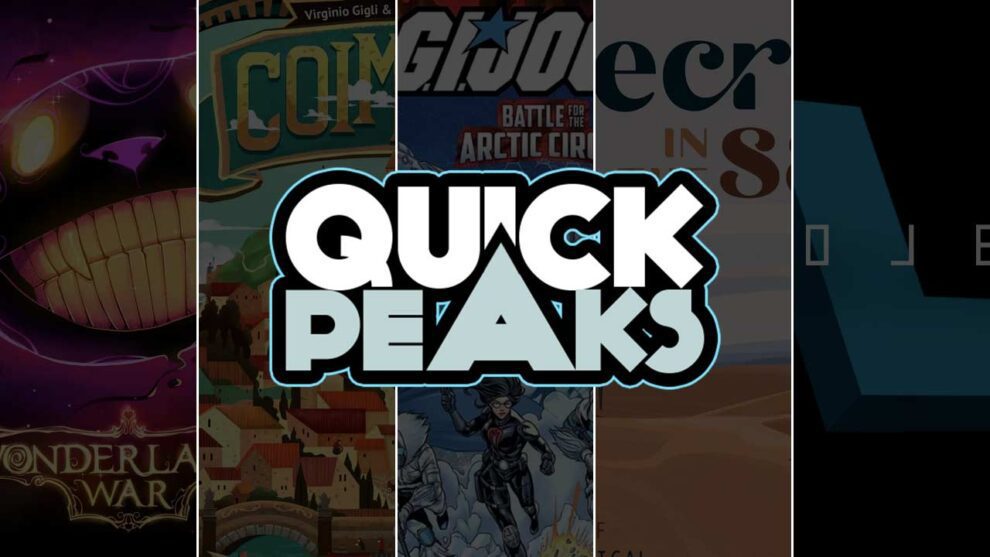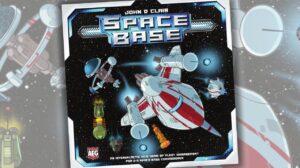Wonderland’s War – K. David Ladage
I can recall when I first saw this online. I read about it and thought the idea was interesting. I was (and am still) dealing with the issues involving another game based around childhood favorite set of stories (Adventures in Neverland), and so I shied away from backing this. After getting a chance to play this at Congress of Gamers, I am very sad that I passed. This was a wonderful romp!
The game is not too complicated, but can create some brain-burning choices as you move through your turn. There is the Tea Party phase where each player will be attempting to gain cards to grant them tokens to use in their bag or to increase their main character’s power level or what-have-you. Then there are the five battles in disparate locations about Wonderland, where you supporters can aid you by making you more resilient to the madness of this place. The Tea Party is interesting and fun, the battles involve pushing your luck with the bags you are managing, and thanks to the wagering mechanic, there is no point in the game where you are not engaged. I have to see if I can get myself a copy of this one.
Ease of entry?:
★★★☆☆ – There were a few questions
Would I play it again?:
★★★★★ – Will definitely play it again
Read more articles from K. David Ladage.
Coimbra – Bob Pazehoski, Jr.
Folks seem to get excited about multi-use cards, but what about multi-use dice? I had my eye on Coimbra for a long time, and then it sat on my shelf for a couple months in the queue. I finally brought it to the table and it was everything I had hoped it would be. We played with four players, which I would imagine is the most interesting if for no other reason than human agency and unpredictability are at their peaks.
Players draft dice (fantastic), which are placed in action areas to determine the order of resolution (fantastic), which in most areas then become the price to be paid for character cards (also, fantastic), which then determine—by their color—which tracks develop to trigger bonuses. Every decision is layered, making the dice placement the thinky bit. But then the rounds increasingly roll downhill as dreams are realized or dashed and the abundance of the cards and tracks pour forth. There’s a load of interaction on the board, and there seem to be several viable strategies. In short, Coimbra is a gem. Check out Justin’s review for a deeper look, and then find a table where you can play.
Ease of entry?:
★★★★★ – No sweat
Would I play it again?:
★★★★★ – Will definitely play it again
Read more articles from Bob Pazehoski, Jr.
G.I. JOE: Battle for the Arctic Circle – K. David Ladage
I do not have the space in a Quick Peaks article to tell you just how excited I was when I first discovered that someone had combined the Axis & Allies game engine with the world of G.I. Joe. That said, it was not more than ten minutes after I was given this information that I ordered my copy. I recently had a chance to play, and I was not disappointed!
The production values are decent (on par, I would say with the original release of Axis & Allies). My only complaints as far as that goes would have to do with how thin the various tokens and the player aids are. If those were about twice as thick as they are now, I would have nothing bad to say about the production at all. The game play is excellent, with forces on both sides that are just different enough to be distinct without being unbalanced in any way. Add to this that each player has a special ability based on the commander they are playing (Cobra Commander is not Destro; Snow Job is not Adm. Keel Haul); each ability feels right and has a very distinct impact on how they are played. And there are three scenarios to choose from, each with an impact on how the game starts and the victory conditions. I want to play a lot more of this! Go Joe!
Ease of entry?:
★★★★★ – No sweat
Would I play it again?:
★★★★★ – Will definitely play it again
Read more articles from K. David Ladage.
Secrets in the Sand – Justin Bell
I had a bad feeling when I read the rules for Secrets in the Sand (2023, Canterville Games). The gameplay seemed built around a thin premise: randomly plot a place on a large map of a desert where a tomb has to be located by players, then randomly determine where each adventurer begins the game.
Players flip a card, revealing a number of steps each player can move from any of their existing camps. Whoever finds a viable path first gets to place a camp…which means no one else takes a turn, basically. Yes, that means there’s a chance that one player might not take an action for the entire game, if they lose that mental race too often. Despite these concerns, I asked my wife (thanks honey!) to do a two-player game before I showed this to my full review group. Our game lasted eight minutes. Her camp placements led to zero treasure cards revealed, thanks to another random mechanic where cards are drawn from a deck, many of which literally say “Nothing.” She was able to place camps faster than I could on most turns, leading to her win in that short timeframe.
The BGG listing for Secrets in the Sand has removed all design credits, so I get the sense the team with Canterville knows how this game is landing with others given the lack of coverage I could find on the interwebs. This is not a game I will revisit; worse, I’m not sure this is technically a game, given the possible lack of competition if players are not able to take a turn.
Ease of entry?:
★★★★★ – No sweat
Would I play it again?:
☆☆☆☆☆ – No chance
Read more articles from Justin Bell.
Project L – K. David Ladage
Project L is an abstract game that leans into the polyomino concept so hard, there is no room for anything else. Where some games might use polyominoes as a mechanic that grants you access to some other mechanic, or as a bridge from one part of the game to another, Project L has you using polyominoes to solve polyomino puzzles that grant you access to more polyomino pieces so you can solve larger, more complex polyomino puzzles. The larger and more complex the puzzle, the more points you receive. End of description. This was an oddly satisfying game, and one I would love to play again. That said, one member of my game group has this, so I have no desire to rush out and buy a copy.
Ease of entry?:
★★★★☆ – The odd bump or two
Would I play it again?:
★★★★☆ – Would like to play it again
Read more articles from K. David Ladage.















